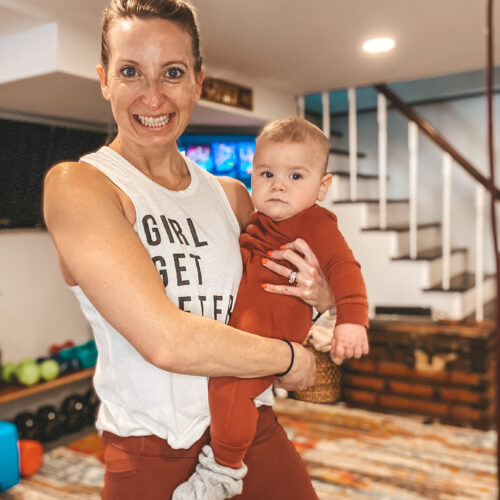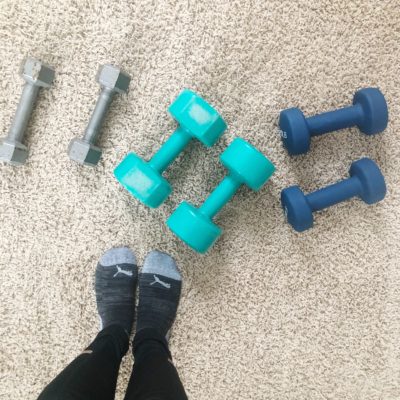I’m a dietitian and I still freaking hate this part of every week. BUT just like folding laundry it feels awesome to get it done and is a necessary component to a less stressful day and week, and that carries over into other areas positively in life too.
The weeks that I make a point to dedicate 10 minutes on Saturday or Sunday to plan for the week ahead, I am a more patient mom to my boys daily, a happier spouse to be around, and save money. Hard to turn down those perks all due to laziness and improper time management. Don’t get me wrong — I completely can relate to feeling as if you have no additional time in your day to even get done the bare necessities (heck, some days a shower doesn’t even happen), and ya know what — you don’t have additional time. No one does. No one has 24 hours and 10 minutes in their day. We all just have the same 24 hours. The difference is your mindset, priorities, and how you spend your time. That could be a series of blog posts on its own, so for today I’ll just cover some simple ways to hack your meal prep and planning for the week.
Assess Your Calendar
Maybe a precursor to this step is to get/have a monthly calendar. I talk all about my favorites in this blog post if your curious which ones I find helpful and how I use them.
The first step in planning meals is knowing what you have going on each day so you know if you’ll be home or on the go (pre, during, and post dinner), how much time you’ll have to prep, and how many meals to plan for the week. Check out your schedule for the week, and to be on the safe side also check-in with a spouse or significant other at this time too in case last-minutes plans have come up or if you forgot anything.
Make note of what each day entails, and then start planning dinner meals. These are the only meals that I plan out for the week — breakfast is typically about the same options that I rotate through, consisting of things like eggs, bacon, protein shakes, full-fat yogurt & fruit, or potentially an egg bake dish I make on Sunday to have a few days throughout the week. Lunches are left-overs from the night before, so in order for that to happen we make a bit extra at dinner. So, all that I’m left with for meal prep are dinners.
Utilize a Dry Erase Board
A staple in my meal planning process is a magnetic dry-erase board that we keep on our fridge. This magnetic marvel has been such a game-changer for me and my husband! There are all sorts of different options out there, but for starters I opted to get a less expensive one from Target. Check out this one that is very similar to the one I purchased years ago and still use to this day. I recommend getting a dry-erase board that has 7 spaces on it — one for each day of the week. After reviewing the family calendar, I’ll choose one marker color (red) and make note of any activity happening at/around dinner time, and then write out our plans for dinner in a different color (blue).

I’ve even found nicer, more sleek-looking menu boards that I would love to get, such as this one from Style + Dwell. It is such a gorgeous addition to any kitchen and what a positive reinforcement to weekly meal prep!

Plan 4-5 Meals for the Week
Yep, there are seven days in the week, and no I do not plan for all seven. It’s one of the ways the whole process of meal prep is more doable and realistic for me. Weekends sometimes have set plans weeks ahead of time, but often we’re a sporadic family and don’t know what the day holds when we get up on Saturday or Sunday.
We typically have one meal out over the weekend, whether it is at a restaurant as a family (great practice for teaching the boys patience, manners, polite etiquette out, etc.), get together for a meal out with friends, or are at family’s house for dinner, and so that’s another reason why I only plan for 4-5 meals at home.
So start there — pick the days out of your week that you will make a dinner and use that as your launching point. Next up comes picking the food!
Keep it Simple
I cannot reiterate this point enough to my clients (and family, friends, etc.): do not over-complicate eating. I completely get it and I too, am bombarded daily by the differing and conflicting messages around what to eat and what not to eat. The best way to keep your cool is to think back to your grandparents and great grandparents lives’ and lifestyles– what were they doing and what types of foods were they eating? Most of them were very active, whether it was farming, doing physical labor, chasing children, etc. And their food sources were grown locally (by their family no doubt) and consisted of plenty of vegetables and fruit, humanely raised livestock, and minimal processed foods as side items such as whole grains, rice, etc.
How I plan my meals is focusing on three food groups: protein, vegetables, healthy carbohydrate/starch. For every dinner those are the things I keep in mind, and by doing that in just a few minutes I plan out my dinner plus 3-4 others for the week and a shopping list to go with it.
Pick Your Protein
Variety, along with simplicity, is key when it comes to meal prep. When it comes to planning a meal, one of the ways I find it easiest is to break the meal up into 3 items — a protein (meat), vegetable, and healthy carb/starch. Although the veggies are the item that ideally take up the most room on our plate, I like to first figure out the protein and plan around it.
Since I plan for 4-5 meals each week, I usually have 3-5 different protein options — a different one for each day with sometimes a repeat like chicken or turkey. A protein would be foods like chicken, beef, turkey, fish, pork, shellfish, etc. (think meat that comes from animals). These are a great addition to meals to provide protein to our body and vital nutrients for growth, muscle maintenance and repair, energy, and overall health. It also helps stabilize our blood sugar and therefore hunger levels, energy levels, mood, and more.

Don’t get me wrong, protein doesn’t have to be found solely in animal products, but it is a great option and most nutrient-dense. My family doesn’t have any restrictions or avoidances at this time to animal products, but we do from time to time and other family members follow a vegetarian diet. And it goes without saying, I respect your lifestyle choices if you do not consume meat! You can swap out my recommendations for animal protein for your plant-based options!
Choose Your Favorite Vegetables
As I mentioned earlier, your veggies should take up more space on your plate than anything else — consider them your entree. In my opinion, this is where most Americans go wrong, as we think of them as something we might have on our plate 1-2 times a week, and in a serving size the equivalent of a couple of bites.
For optimal health, vegetables should take up half of your plate. Let me say it again for people standing in the back– veggies need to occupy half of your dinner plate. Now obviously, the majority of people are no where near that currently, so making that big of a shift is most likely not realistic. So potentially for starters, for you it might mean that you’re making it a point to actually include vegetables at every meal.
When it comes to veggies, not only are many people not accustomed to eating them on a regular basis, but their pallet and taste-preferences is…minimal. The starchy ones like carrots, peas, and corn might be old tried-and-true veggie go-to’s, but things like spinach, Brussels sprouts, and asparagus bring flashbacks of disgusting foods they were forced to eat as kids.
What I recommend is to pick a vegetable that you like. Green beans are typically a good option and like most veggies come in either fresh, frozen, or canned so you have a variety of ways you could opt to eat them. I also say vegetables, especially fresh and/or frozen are best with healthy fats and spices/herbs. Prepare them so that they taste good and you will eat them! Most people have at least 2-3 vegetables that they can at least tolerate, so for your first week or so with meal planning stick with those. However, I also have to challenge you to expand your horizons and gradually try other vegetables. Pinterest is such a great way to learn easy ways to have veggies and other meals.
Round Out Your Plate
The third and final food group I consider when meal planning is a healthy carbohydrate/starch. These could be foods like potatoes, sweet potatoes, rice, whole grain rice, quinoa, etc. To really make meal prep and planning easy, this is usually the food category that I keep a few items on hand in my pantry or freezer.
Frozen rice, or better yet frozen cauliflower rice, has been an awesome easy and tasty addition to many of our meals. Another option we utilize at times have been frozen tater tots (laughable, I know), but again — super easy to have on hand and are a quick addition to meals. Otherwise, tossing a few potatoes in the microwave for 3-5 minutes to make baked potatoes is a great alternative to a heaping mound of pasta.
For a few meals throughout the week, we’ll do a side salad rather than a carb/starch. Therefore, the meal would consist of a protein, vegetable, and salad. Probably a bit confusing, since a salad is made up of vegetables so it would be considered more like: protein, vegetable, vegetable. Regardless, just a simple salad– sometimes even a prebagged salad kit, rounds out our meal.
That’s pretty much it! Assess your week, pick 4-5 days to plan meals for, then choose a protein, vegetable, and healthy starch for each day. Done and done. Once you start to get in the habit of meal planning you can get a bit more create with your dishes and ingredients, but for starters keep it simple. Chicken, broccoli, sweet potato. Salmon, asparagus, frozen rice. Utilize the internet and sites like Pinterest to add a bit of flavor, but all in all simple planning and prep will be a phenomenal start!


